CHAPTER 19: Other agile implementations
The Competitive Edge for Modern Project Managers
19.1 Agile, Scrum, and Beyond – How It All Fits Together
Agile, Scrum, and Beyond – How It All Fits Together
When people first hear about Agile, they often think immediately of Scrum. This is understandable, because Scrum is the most widely used Agile framework in the world. However, Agile is not limited to Scrum. In fact, Agile is a broad umbrella that covers many approaches, methods, and practices. Each of them shares the Agile values and principles, but each applies them in a different way. Understanding how Scrum fits into the wider Agile landscape helps you choose the right approach for the situation at hand.
Agile as a Mindset
Agile is not just a set of processes or tools. It is a mindset based on values and principles. These values include focusing on individuals and interactions, working solutions, customer collaboration, and responding to change. The principles that flow from them emphasize frequent delivery, adaptability, and customer satisfaction. When we say Agile, we are really talking about this mindset first. All frameworks, including Scrum, Extreme Programming, Kanban, or Crystal, are simply ways to live out these values in practice.
Why Scrum Became So Popular
Scrum became the dominant Agile framework because it is lightweight, simple to understand, and adaptable. It provides clear roles, events, and artifacts that create structure for teams. With time-boxed sprints, a prioritized backlog, and frequent feedback loops, Scrum makes Agile tangible and accessible for organizations. However, Scrum does not cover everything. It does not tell you how to engineer software, manage flow in a production environment, or handle highly specialized domains. This is why other Agile approaches exist alongside Scrum.
Other Agile Methods Under the Same Umbrella
Scrum is just one member of a larger Agile family. Extreme Programming, often called XP, focuses on engineering practices like test-driven development, pair programming, and continuous integration. Kanban is a flow-based method that helps teams visualize work and optimize throughput. Crystal emphasizes tailoring practices to the size and criticality of the project. DSDM and Feature-Driven Development offer structured approaches that predate or evolved alongside Scrum. All of these approaches fulfill the Agile values, but they emphasize different practices to solve different types of problems.
When to Go Beyond Scrum
Scrum alone may not be enough to address all the challenges of a project. For example, if you need strong technical practices, you might combine Scrum with Extreme Programming. If your team works on operational or support work with unpredictable demand, Kanban may be a better fit. If your organization prefers more structured lifecycle guidance, then DSDM or Feature-Driven Development could provide the additional scaffolding. This blending of approaches is very common in practice, because no single framework works best in every situation.
Scrum as a Gateway to Agile
For many organizations, Scrum is the entry point into Agile. It is often the first framework they try, because it gives immediate structure and a common vocabulary. Once teams are comfortable with Scrum, they begin to explore other Agile methods to address gaps. This evolution shows that Agile is not about adopting a single recipe. It is about understanding the values, experimenting with practices, and continuously adapting to improve outcomes. Scrum may start the journey, but the destination often includes a mix of practices from across the Agile spectrum.
The Bigger Picture
Agile is a wide field. Scrum, XP, Kanban, Crystal, DSDM, and Feature-Driven Development are all valid ways to live out its principles. None of them is Agile by itself. They are simply different paths to the same goal of delivering value to customers faster, with less waste, and with greater adaptability. As a project manager or Scrum Master, your role is not to be loyal to one framework but to understand how they fit together, and how to apply them in a way that helps your team and organization succeed.
19.2 Extreme Programming (XP) – Practices for Engineering Excellence
Extreme Programming – Practices for Engineering Excellence
Extreme Programming, or XP, is one of the earliest Agile methods, developed in the 1990s. While Scrum focuses on project management and collaboration, XP emphasizes the technical side of software development. It provides concrete engineering practices that help teams build high-quality code quickly and adapt to changing requirements with confidence. Many Agile teams use Scrum for structure and XP for engineering discipline, combining the best of both worlds.
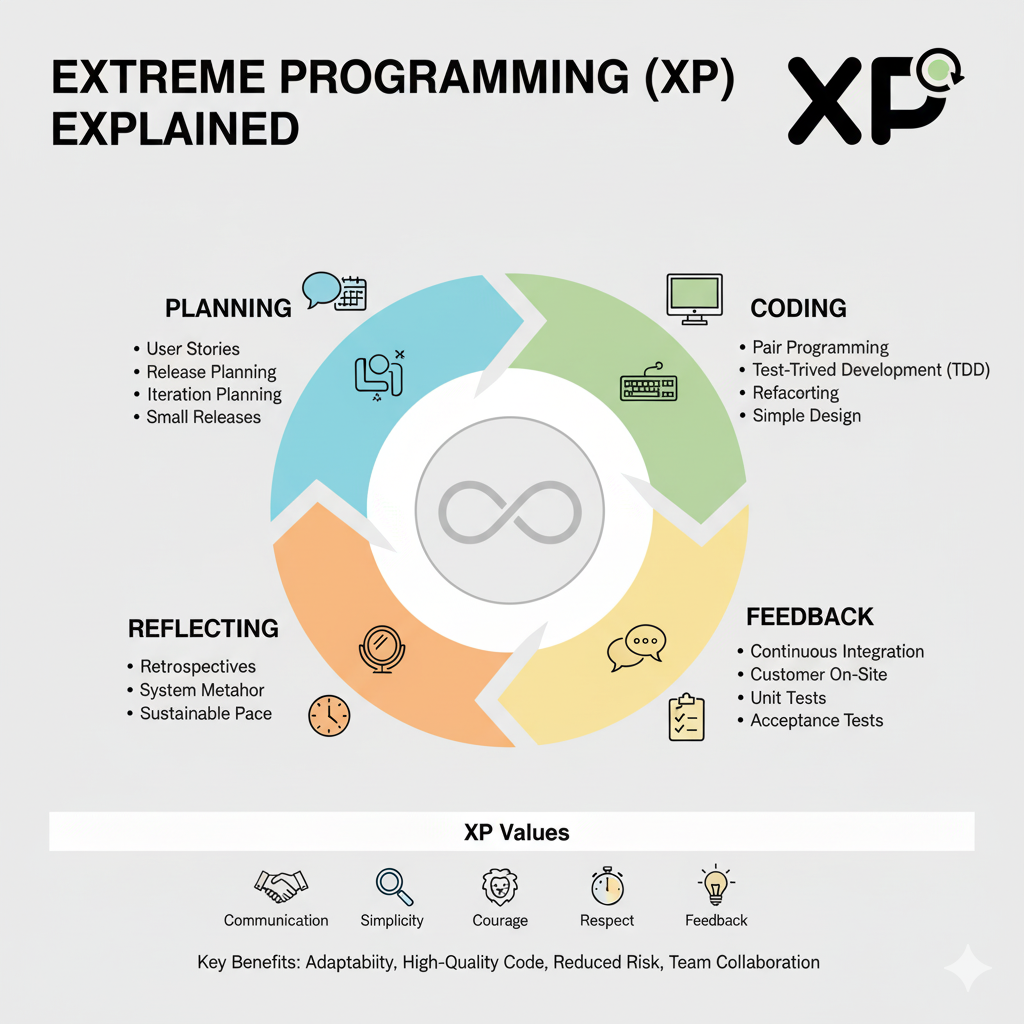
Why XP Matters
One of the key Agile principles is continuous attention to technical excellence. Without strong engineering practices, Agile projects can quickly accumulate technical debt, slow down, and lose flexibility. XP addresses this by promoting habits that keep the codebase clean, tested, and easy to change. Even if your team does not adopt every XP practice, understanding its core ideas helps you see what excellence looks like in Agile development.
Core Ideas Behind XP
XP is built on the values of simplicity, communication, feedback, courage, and respect. Simplicity means writing only the code that is needed right now. Communication ensures that developers, customers, and testers work closely together. Feedback comes through automated tests, code reviews, and customer involvement. Courage is the willingness to refactor, throw away bad code, or challenge assumptions. Respect ensures the team works as equals, regardless of role. These values guide all of XP’s practices.
Key Practices in XP
XP promotes a set of well-known engineering techniques that work together to produce high-quality results:
- Test-Driven Development, where developers write automated tests before writing the code itself.
- Pair Programming, where two developers work at one workstation, improving quality and sharing knowledge.
- Continuous Integration, where code is integrated and tested frequently, often many times per day.
- Refactoring, where code is regularly cleaned up and simplified to avoid complexity and duplication.
- Collective Code Ownership, where any developer can improve any part of the codebase, avoiding silos.
- Small Releases, where working software is delivered frequently to get rapid customer feedback.
How XP Fits With Scrum
Scrum gives teams a framework for organizing work, but it does not dictate how the actual coding should be done. XP fills this gap by offering practical, proven engineering practices. For example, a Scrum team can run its sprints and backlog management as usual, but during the sprint, developers follow XP practices like test-driven development and pair programming. Together, they make Agile delivery both sustainable and technically sound.
Benefits of XP
Teams that adopt XP practices enjoy faster feedback, fewer defects, and greater confidence in their code. They can respond to changes without fear of breaking the system. Pair programming improves knowledge sharing and reduces bottlenecks. Continuous integration ensures that problems are caught early instead of at the end of a project. Over time, these practices lead to a more sustainable pace of development, higher team morale, and happier customers.
Challenges and Adaptation
XP requires discipline. Practices like pair programming or test-driven development may feel uncomfortable at first. They may even seem to slow things down in the beginning. But with time, teams find that the investment pays off with fewer defects, less rework, and faster delivery. Many organizations choose to adopt XP practices gradually, focusing on one or two at a time. This approach allows teams to build confidence and see benefits early without overwhelming themselves.
XP as a Path to Excellence
Extreme Programming is not about doing something radical for the sake of being extreme. It is about taking good engineering practices and applying them consistently and rigorously. In an Agile context, where change is constant and speed matters, this level of technical discipline is what keeps teams moving forward. Whether you adopt all XP practices or only a few, the spirit of XP—commitment to quality, collaboration, and adaptability—remains an essential part of delivering value through Agile.
19.3 Kanban – Flow-Based Agile
Kanban – Flow-Based Agile
Kanban is another important Agile approach, but it looks very different from Scrum or XP. Instead of working in time-boxed sprints, Kanban focuses on continuous flow. Teams using Kanban visualize their work on a board, limit how much work is in progress at once, and optimize the flow of tasks from start to finish. This makes Kanban especially powerful for teams dealing with unpredictable demand or continuous streams of work, such as operations, support, or maintenance.
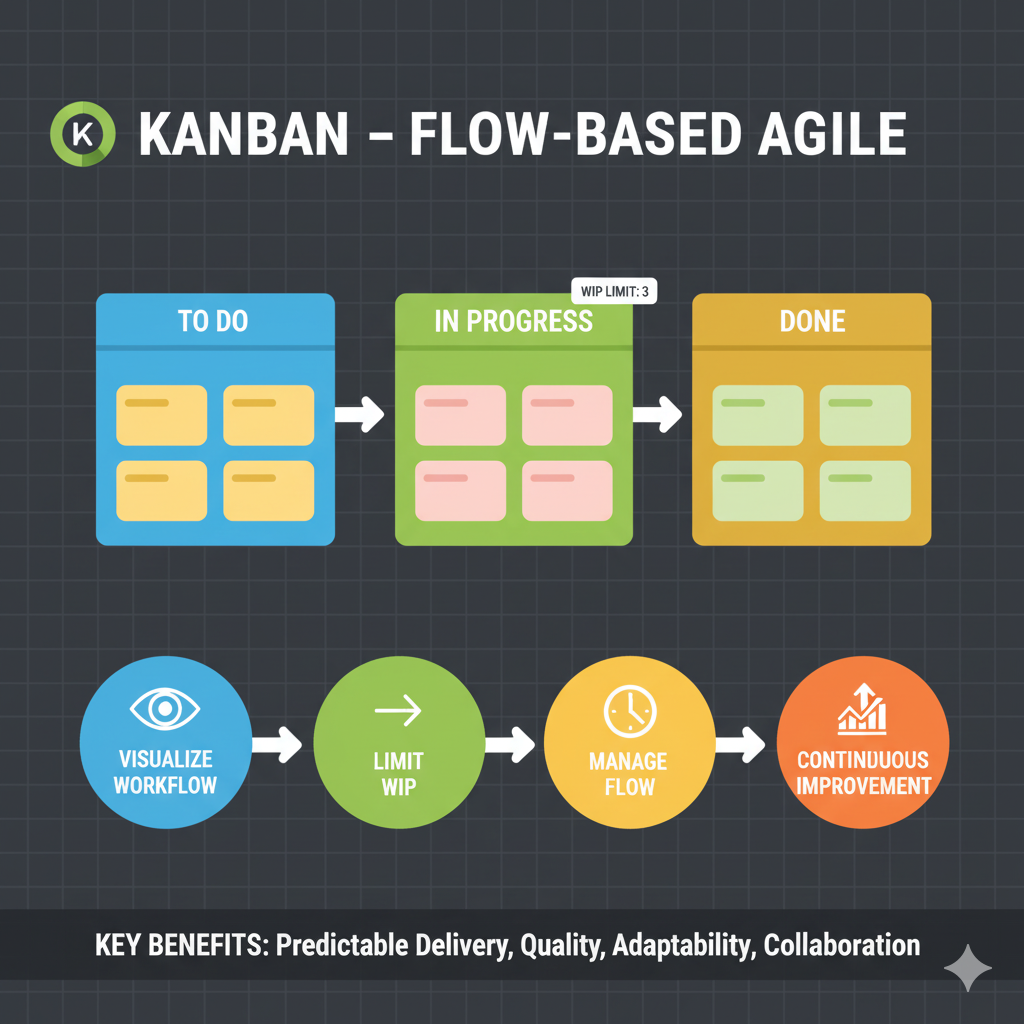
Core Principles of Kanban
At its heart, Kanban is based on three principles. First, visualize the workflow, usually through a board with columns such as “To Do,” “In Progress,” and “Done.” Second, limit work in progress so the team does not start too many things at once. This reduces multitasking and bottlenecks. Third, manage flow by measuring how long work takes and making improvements to smooth delivery. These simple ideas create transparency, focus, and predictability without heavy structure.
How Work Moves in Kanban
Unlike Scrum, Kanban does not require fixed-length iterations. Instead, tasks enter the workflow whenever capacity allows, and they flow across the board until completed. Each item represents a piece of value, such as a user story, bug fix, or support ticket. Because work-in-progress is limited, new items can only be started when space opens up. This creates a pull system, where work moves at the pace the team can handle, not at the pace stakeholders push into the system.
Benefits of Kanban
Kanban is highly flexible. It works well for teams that cannot plan work in fixed sprints or where priorities shift quickly. By visualizing all work, it becomes clear where tasks get stuck and where improvements are needed. Limiting work in progress improves focus and quality, because the team finishes more items instead of juggling too many at once. Over time, measuring flow leads to better predictability of how much work can be delivered, which helps stakeholders plan with confidence.
When to Use Kanban
Kanban is especially useful in environments with a steady flow of incoming requests, such as IT service desks, DevOps teams, or marketing groups handling campaigns. It also suits knowledge work where tasks vary in size and urgency. Some software teams use Kanban alongside Scrum, sometimes called Scrumban, to get the best of both approaches. In these cases, Scrum provides rhythm and roles, while Kanban adds flow management and flexibility.
Challenges and Considerations
Kanban’s simplicity can be misleading. Without discipline, teams may ignore work-in-progress limits or fail to improve their flow. Unlike Scrum, Kanban does not define roles or ceremonies, so teams must create their own ways to ensure collaboration and accountability. Success requires continuous attention to metrics, such as cycle time and throughput, and a commitment to making small, ongoing improvements. In many organizations, the hardest part is cultural—teaching stakeholders that pulling fewer tasks at once actually delivers more value faster.
Kanban as a Path to Flow
Kanban is not just a board on the wall. It is a philosophy of managing work based on flow, transparency, and balance. By limiting work in progress and focusing on completing tasks efficiently, teams can deliver value steadily and predictably. Whether used alone or blended with other Agile methods, Kanban equips teams with powerful tools to handle dynamic environments. For Agile practitioners, understanding Kanban means having another versatile option to adapt Agile principles to real-world demands.
19.4 Crystal and Lightweight Agile Methods
Crystal and Lightweight Agile Methods
Crystal is one of the lesser-known Agile methods, but it offers a valuable perspective on flexibility and tailoring. Developed by Alistair Cockburn, Crystal is not a single framework but a family of lightweight approaches. The core idea is that different projects need different methods, depending on their size, criticality, and complexity. Instead of prescribing strict rules, Crystal encourages teams to adapt their practices to the context while staying true to Agile values.
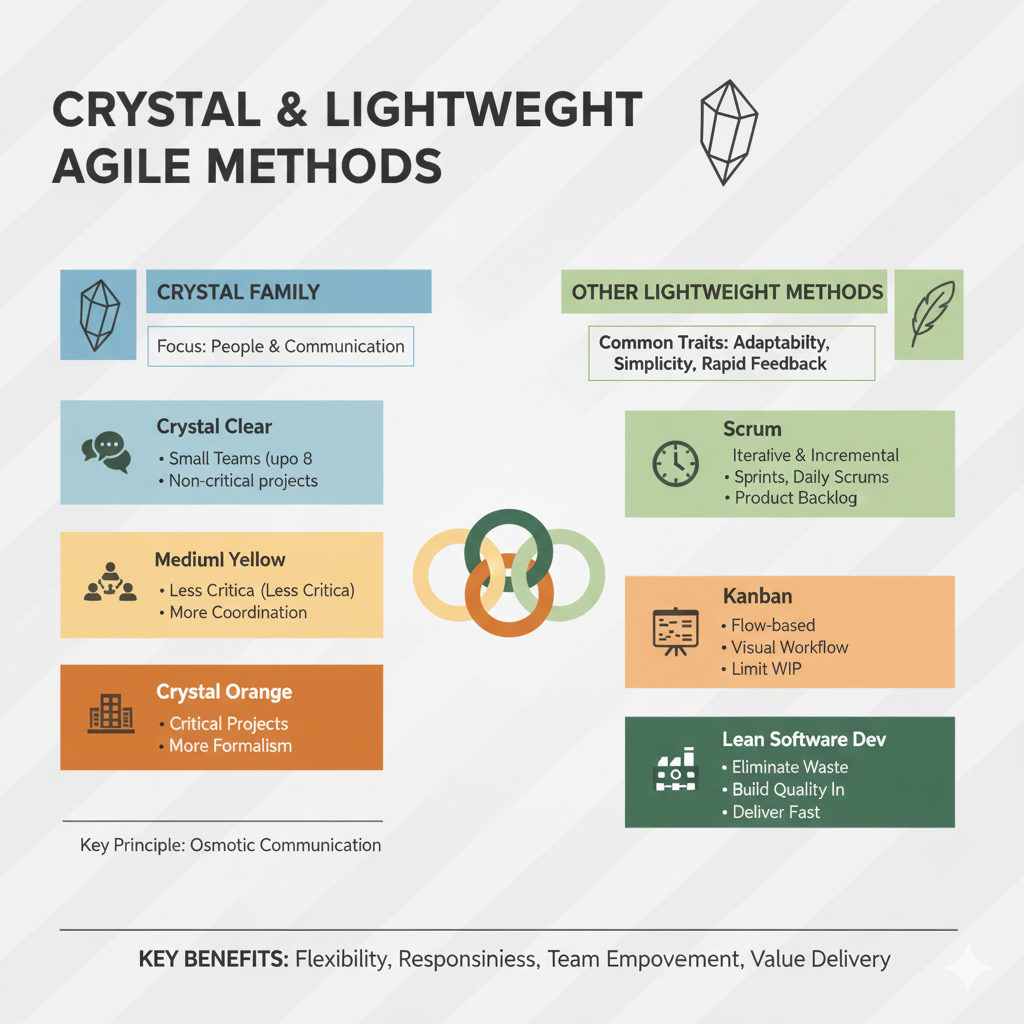
The Philosophy Behind Crystal
Crystal emphasizes that people and interactions matter more than processes and tools. It recognizes that every project is unique, so no single method fits all situations. Crystal encourages teams to select the lightest set of practices that will allow them to succeed. The goal is to maximize efficiency, minimize overhead, and focus on delivering value. This means that what works for a small startup may not be right for a safety-critical system in a large enterprise.
Colors of Crystal
Crystal uses colors to represent different methods tailored to project size and criticality. For example, Crystal Clear is suited for small teams of up to six developers working on low-risk projects. Crystal Orange or Crystal Red are for larger, more critical projects where more structure is needed. The higher the risk and complexity, the “darker” the Crystal method becomes, meaning more practices are added to support quality and safety. This color system reminds us that agility is not one-size-fits-all.
Key Characteristics of Crystal
Despite its variations, all Crystal methods share certain principles. They emphasize frequent delivery, reflective improvement, and close communication with users. They encourage osmotic communication, meaning information flows freely in a shared workspace. They also stress the importance of safety in communications—creating an environment where team members feel safe to raise concerns and share ideas. Above all, Crystal treats methodology as a tool to serve the team, not a burden to control it.
Other Lightweight Agile Approaches
Crystal is part of a broader category of lightweight Agile methods. These methods aim to reduce bureaucracy and provide just enough process to keep teams aligned. Examples include Adaptive Software Development, which emphasizes cycles of speculation, collaboration, and learning. Another is Lean Software Development, which applies lean manufacturing principles like eliminating waste and amplifying learning. These approaches share the idea that agility comes from simplicity and adaptability, not heavy structures.
When to Use Lightweight Methods
Lightweight methods like Crystal work best in environments where teams are small, communication is easy, and the cost of mistakes is manageable. They are attractive for startups, innovation teams, and exploratory projects. However, they may be less suitable for regulated industries or large, distributed projects where more formality is required. The strength of these methods lies in their adaptability—teams can start light and add practices as needed, rather than beginning with heavy processes.
The Value of Crystal and Lightweight Approaches
Crystal and similar lightweight methods remind us of an essential Agile lesson: agility is about people, not rules. By focusing on communication, simplicity, and continuous improvement, these methods encourage teams to evolve their way of working. Even if your organization never formally adopts Crystal, understanding it broadens your perspective on Agile. It highlights the importance of tailoring methods to context, and of keeping process overhead as low as possible while still achieving excellence.
19.5 DSDM and Feature-Driven Development (FDD)
DSDM and Feature-Driven Development (FDD)
Two Agile methods that are less widely used today but remain important in the history of Agile are DSDM and Feature-Driven Development. Both emerged in the 1990s, before the Agile Manifesto was written, and both contributed ideas that influenced later frameworks. While they are less common in modern practice, understanding them gives you perspective on how Agile evolved and provides additional options for tailoring approaches in complex organizations.
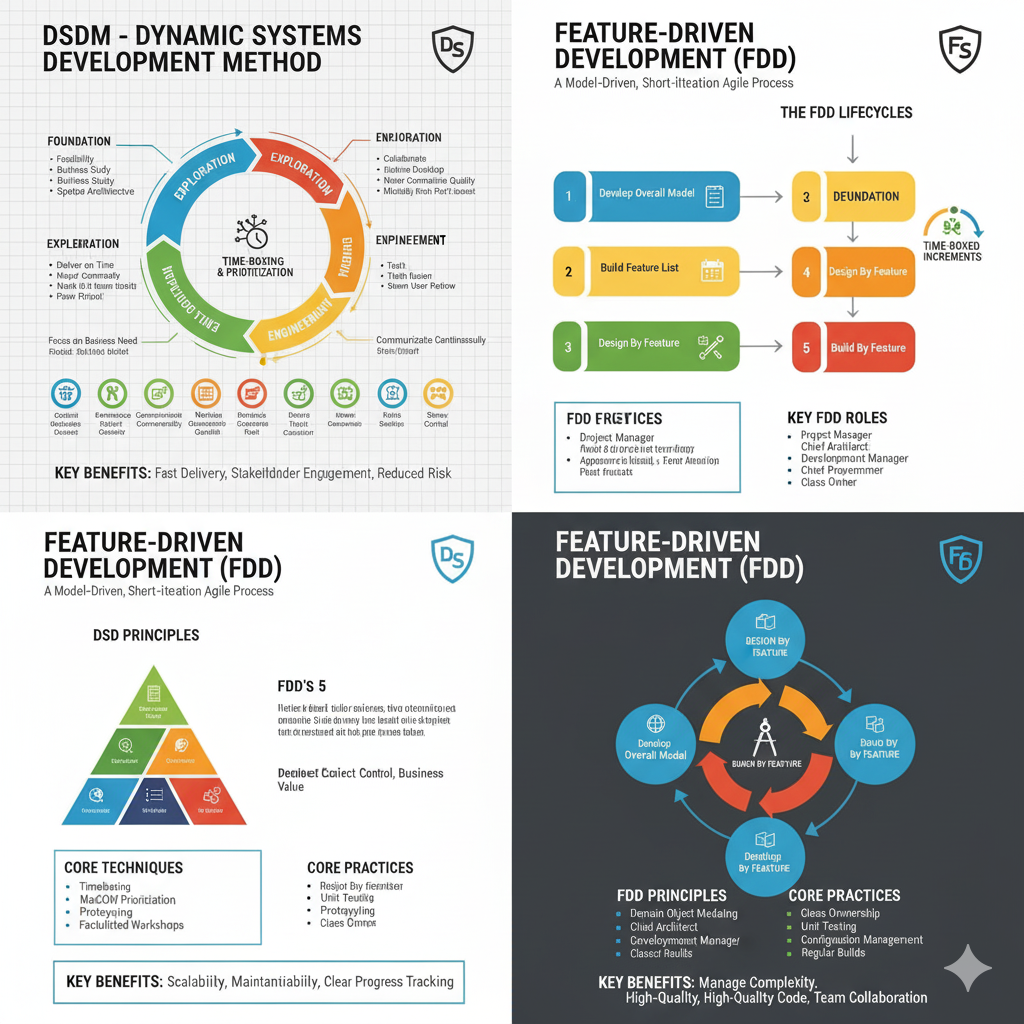
Dynamic Systems Development Method (DSDM)
DSDM began in the mid-1990s in the United Kingdom as a response to long, expensive IT projects that often failed to deliver value. It was one of the earliest attempts to formalize an Agile-like approach. DSDM is built on eight principles, including delivering on time, involving users actively, and collaborating closely. It emphasizes incremental delivery, frequent feedback, and fitness for business purpose rather than technical perfection. DSDM also introduced ideas like timeboxing, which influenced Scrum and other Agile methods.
Key Characteristics of DSDM
DSDM is more structured than lightweight methods like Crystal. It defines clear roles, such as business sponsor, business visionary, and technical coordinator. It also prescribes a lifecycle with stages for feasibility, business study, functional model, design, and implementation. Unlike Scrum, which focuses mainly on team-level work, DSDM has always included a strong governance perspective, making it attractive to organizations that need oversight and formal reporting. This balance of agility and governance makes it a bridge between traditional and Agile approaches.
Feature-Driven Development (FDD)
Feature-Driven Development originated around the same time, in large-scale software projects in Singapore. As the name suggests, FDD is centered on features—small, client-valued pieces of functionality. The method begins with creating an overall model, then building a feature list, and then delivering in short iterations where each feature is designed and built. This structured approach made FDD appealing for big projects where architecture and design needed careful planning but agility was still desired.
Key Characteristics of FDD
FDD blends Agile ideas with more traditional engineering practices.
It includes five core activities:
- developing an overall model
- building a feature list
- planning by feature
- designing by feature
- building by feature
Teams work in two-week cycles, and progress is tracked by features completed rather than by tasks or stories. FDD also emphasizes roles such as chief architect, chief programmer, and feature teams. This clear structure helped large teams coordinate, but it also made FDD less lightweight than Scrum or Kanban.
Comparing DSDM and FDD
Both DSDM and FDD sought to solve challenges of their time—DSDM by balancing agility with governance, and FDD by organizing large, design-heavy projects around features. They share Agile principles like delivering value frequently and involving users, but they approach them with more structure than many modern Agile methods. Today, elements of DSDM and FDD often appear inside hybrid frameworks or scaled Agile environments, even if the full methods are less commonly adopted.
Practical Lessons for Today
For today’s Agile practitioner, the main value of studying DSDM and FDD lies in understanding how to tailor Agile in larger, more structured contexts. DSDM shows how to align Agile delivery with business governance, while FDD demonstrates the power of organizing work around features rather than tasks. Even if your team never uses these methods directly, the ideas behind them can help you handle scale, governance, and architecture without losing the benefits of Agile thinking.
19.6 Hybrid and Blended Agile Approaches
Hybrid and Blended Agile Approaches
Not every organization can run purely Agile, and not every project fits neatly into Scrum, Kanban, or XP. This is where hybrid and blended Agile approaches come in. A hybrid approach combines Agile practices with elements of traditional, predictive project management. A blended approach combines multiple Agile frameworks together. Both are common in practice, because organizations often need to balance agility with governance, compliance, or existing ways of working.
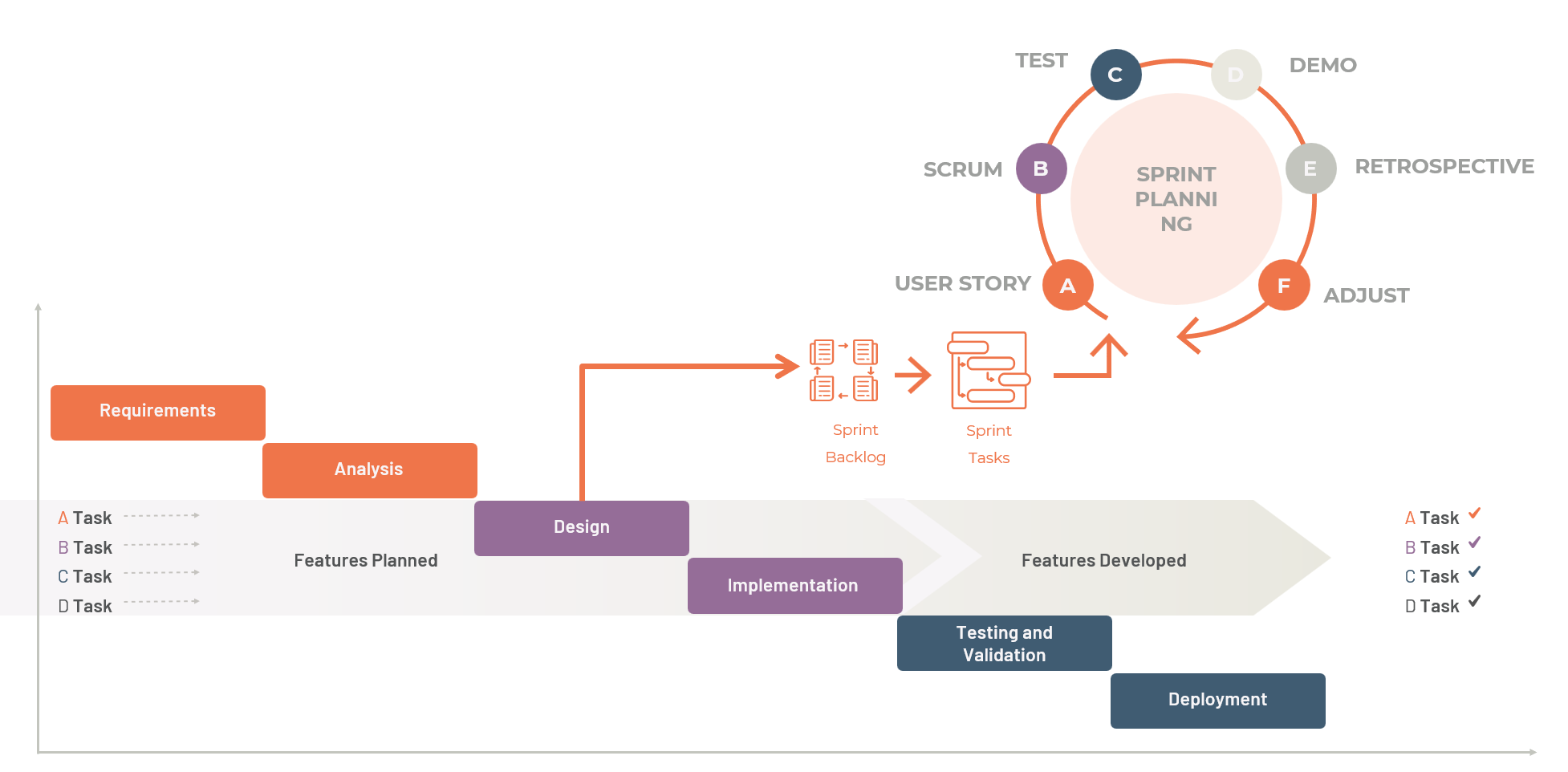
Why Hybrid Approaches Emerge
Many industries, such as finance, aerospace, and healthcare, operate under strict regulations. These organizations cannot abandon planning, documentation, or stage gates completely. At the same time, they want the flexibility and customer focus of Agile. The result is a hybrid approach. For example, a project might use predictive planning for overall budgets and milestones, but deliver increments using Scrum or Kanban. This balance allows organizations to meet compliance needs while gaining the benefits of agility.
Examples of Hybrid Models
Several recognizable patterns exist in hybrid project management. One is “Water-Scrum-Fall,” where requirements and funding are managed traditionally upfront, development is done with Scrum, and deployment is handled through traditional release processes. Another is integrating Earned Value Management with Agile delivery to satisfy financial governance while still working in sprints. Some organizations also apply predictive planning at the program or portfolio level, while letting teams self-organize using Agile at the delivery level. Each hybrid model reflects organizational needs and constraints.
Blending Agile Frameworks
In many cases, teams blend multiple Agile frameworks rather than combining Agile with predictive. For instance, Scrum teams may adopt XP practices like test-driven development to strengthen engineering quality. Kanban practices, such as limiting work in progress, often get layered onto Scrum to improve flow, resulting in “Scrumban.” Large organizations might use SAFe or Disciplined Agile, which themselves are blends of different frameworks. Blending allows teams to pick the best practices from each method and tailor them to their environment.
Benefits of Hybrid and Blended Approaches
The main benefit of these approaches is flexibility. Organizations can adopt Agile without throwing away practices they still need. Teams can customize how they work, choosing what fits best for their context. Hybrids also help organizations transition gradually toward greater agility, rather than making a disruptive, all-or-nothing shift. Blends allow teams to cover gaps, such as using XP’s technical practices alongside Scrum’s management structure. Done well, these approaches give teams both adaptability and stability.
Challenges to Watch Out For
While hybrids and blends are practical, they come with risks. Poorly designed hybrids can water down Agile so much that it loses its benefits. For example, if a project uses Scrum but still insists on rigid upfront requirements and change control, the team may gain little agility. Similarly, blending too many frameworks can create confusion if roles and practices conflict. Success requires clear choices, transparency, and ongoing improvement. Leaders must ensure the approach serves customer value, not just organizational comfort.
Hybrid and Blended Approaches in Practice
Most organizations today operate in some form of hybrid or blended model. Pure Agile is rare outside of startups or software companies. Understanding these approaches prepares you to work in real-world environments where agility must coexist with governance, regulation, or legacy processes. The key is to remember that Agile is not about adopting a single method, but about applying its principles in a way that delivers value. Hybrids and blends, when done thoughtfully, make that possible.
Agile Project Management & Scrum — With AI
Ship value sooner, cut busywork, and lead with confidence. Whether you’re new to Agile or scaling multiple teams, this course gives you a practical system to plan smarter, execute faster, and keep stakeholders aligned.
This isn’t theory—it’s a hands-on playbook for modern delivery. You’ll master Scrum roles, events, and artifacts; turn vision into a living roadmap; and use AI to refine backlogs, write clear user stories and acceptance criteria, forecast with velocity, and automate status updates and reports.
You’ll learn estimation, capacity and release planning, quality and risk management (including risk burndown), and Agile-friendly EVM—plus how to scale with Scrum of Scrums, LeSS, SAFe, and more. Downloadable templates and ready-to-use GPT prompts help you apply everything immediately.
Learn proven patterns from real projects and adopt workflows that reduce meetings, improve visibility, and boost throughput. Ready to level up your delivery and lead in the AI era? Enroll now and start building smarter sprints.
Launch your Agile career!
HK School of Management helps you master Agile and Scrum—faster. Learn practical playbooks, AI-powered prompts, and real-world workflows to plan smarter, deliver sooner, and keep stakeholders aligned. For the price of lunch, you’ll get templates, tools, and step-by-step guidance to level up your projects. Backed by our 30-day money-back guarantee—zero risk, clear path to results.
Learn More HKSM
HKSM
